Spruce Omorika: growing conditions and rules
The word spruce in Serbian sounds Omorika, and in honor of the discovered plant Pancichev. A unique plant was systematized only at the end of the 19th century, because the place of its growth is the mountains of the Balkan Peninsula. There, on the limestone slopes, at an altitude of one and a half kilometers above sea level, there is a Serbian spruce.
A little over a thousand specimens of coniferous trees have survived in the wild on the territory of a reserve in Serbia. It is found in the mixed forests of Bosnia, western Bulgaria. Cultural species of Omoriki are used in European parks, in the landscaping of the countries of northern Europe, America.
Content:
- The best varieties and their description
- Conditions for growing coniferous trees
- Breeding methods, planting
- Wood care tips
- The use of Omorika spruce in landscape design
The best varieties and their description
The tree is characterized by a narrow, slender crown, the shape of which remains until old age. The color of the needles on the shoots is dark green, below - with two bluish stripes. The straight trunk reaches a diameter of about a meter, and reaches a height of 40-50 meters. The bark on it is thin, reddish-brown in color. If in young Omorik spruces it is dissected into feathery scales, then in old ones it exfoliates in plates. The branches are located horizontally, and hang down only at the bottom of the trunk, and are shorter in length. Young shoots are light, yellowish, densely pubescent, like felt.
Serbian spruce Omorika begins to bear fruit in the twelfth year of life.
The cones of the tree are very beautiful - at first they are light red, then they turn into purple-violet or black with a bluish tinge. The maturity of the cones is determined by the red-brown color, along the length of five to seven centimeters. Inside them is a seed with a narrow membranous wing just over two millimeters in length.
Several varieties of Omorika spruce have been bred, among which are known:
- Spruce Gnome, reaching at twenty years of life one and a half meters in height. Shoots of trees are thin, flexible with shiny green needles, which have 4-5 white lines on top.
- In the Nana variety, the conical crown reaches three meters in height. The tree is distinguished by an interesting color of needles - yellow-green above, blue below.
- Up to ten meters trunk Pendula Bruns with a narrow dense crown.
- With a rounded crown, the Minima variety, it reaches a height of up to thirty centimeters.
The decorative appearance of Serbian spruce is actively used in the design of parks and suburban areas.
Conditions for growing coniferous trees
The unpretentiousness of the spruce from the Balkans helps it to be popular in many countries with unfavorable climates. The breed of conifers is resistant to cold winds, tolerates cold up to minus forty degrees.
The composition of the soil for the Serbian spruce is not important, it feels great on podzolic, sandy soils.
But it grows well on loams, does not tolerate stagnant moisture. It is necessary for planting Omorika spruce so that the soil is loose. Compaction of the soil will lead to stunted growth of the tree.
The decorative type of coniferous tree will prefer a drought of high humidity. Both sunny and slightly shaded places are suitable for him. Urban gas pollution, ambient air pollution is easily tolerated. The use of the species in landscaping is based on the fact that the spruce grows quickly and lives up to three hundred years.
Breeding methods, planting
Like all conifers, Omorica reproduces seeds, cuttings and with the help vaccinations:
- In nature, thanks to the wings, the seeds of a tree fly several kilometers, fall to the ground and can lie without germinating for up to ten years. For breeding, ate seeds are soaked in water for a day before planting, and then planted in a prepared hole. In the spring, a thin stalk will appear, in a year it will be no more than four centimeters high. If at first the tree grows slowly, then the growth rate increases, which will be noticeable by the new whorls of the branches. The first of them appears from the fourth or third year of the spruce's life.
- For cuttings use shoots from the top of the crown. First, the cuttings are planted in a greenhouse. A twig planted obliquely to a depth of three centimeters is watered abundantly, covered with a film. When planting in spring, a sprig is sprayed from a watering can once a day, in the summer, increasing the moisture content up to four times a day. Rooting will take place in August, then the shelter is removed.
- For grafting, cuttings are harvested in November, and then the procedure is carried out in the spring or summer until mid-June. Oblique cuts on the scion, cuttings, combined with the stock. The vaccination site is wrapped with sterile plastic tape and smeared with garden varnish. Care for a grafted seedling is more thorough than for an ordinary tree.
You can plant a Christmas tree by purchasing its seedling from a reliable manufacturer. Like all conifers, a rooted tree is planted in mid-spring. Although it is possible in the last days of August. The landing pit is made fifty centimeters deep. For several specimens, spruce is kept at a distance of two or three meters from each other.
The bottom of the hole is covered with a drainage layer of broken brick, the rest is filled with sheet earth mixed with peat and sand.
To stimulate growth, add one hundred grams of nitrophosphate, mixing everything thoroughly. During planting, the root collar is left flush with the ground. The seedlings are watered and mulch around the stem with a layer of peat six centimeters. To keep young Christmas trees nearby, there should be trees that will shelter them from the scorching rays of the sun, save them from spring frosts.
Wood care tips
Taking care of Omorika spruce is easy:
- Watering for the first time after planting is necessary, starting in mid-March, with warm water. Then the root system will thaw faster and begin to nourish the tree. Then watered once a week, pouring a bucket of water under the tree.
- Top dressing is applied with mineral mixtures for conifers. You can not fertilize with manure, urea planting Serbian spruce.
- For the winter, only young seedlings are sheltered, throwing a light non-woven material on the tree. He will also save the adults ate from the burning rays of the February sun.
- In late autumn, the trunk circle is mulched with sawdust or peat, in the spring it is dug up with the ground. The first two years of life ate mulch is required. Mature trees do not need frost protection.
- Pests that may appear on the Omorika spruce are destroyed by spraying the crown insecticides... These drugs include Intavir, Decis. Spraying with onion husk infusion, spider mite - treatment with a solution of liquid soap, dandelion infusion will help to cope with aphids.
Care for an unpretentious tree is carried out carefully in the first years of the spruce's life.
The use of Omorika spruce in landscape design
Serbian spruce belongs to highly decorative crops. Thanks to the narrow crown extended upward, the bluish shade of the needles, you can use the tree:
- As hedge... For the territory in the English style, the site is divided into zones with a wall of Omorika spruce. Live borders will be a wonderful backdrop for flowering perennials. This technique will emphasize the sophistication and rigor of the design.
- Fir-trees look beautiful in single and group plantings. They are used to decorate parks and squares. Dwarf varieties of Serbian spruce are interesting in rocky gardens, containers.An elegant crown of medium height will perfectly harmonize with two or three conifers that are contrasting in shape. In nature, the Omorika spruce is adjacent to rowan, maples, white fir, oriental beech. This friendship can be used on the site as well.
- As root system spruce strengthens the soil of the shore of the pond, then, having planted it near the water, weeping options of coniferous and deciduous trees, shrubs are placed nearby.
- The combination of conifers with perennial flowers is especially common. Against the background of dark greenery, they will sparkle brighter dahlias, phloxes, hydrangeas.
The beauty, uniqueness of the appearance of the Serbian spruce will make it possible to compose many landscape compositions with it.
More information can be found in the video:



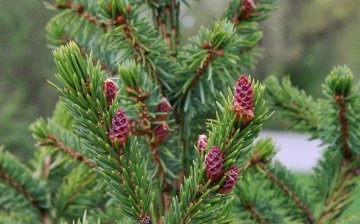
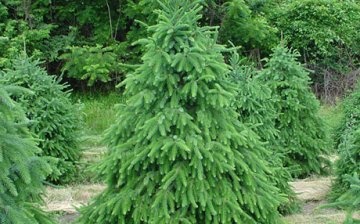

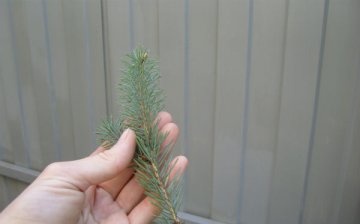

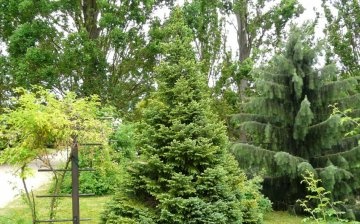






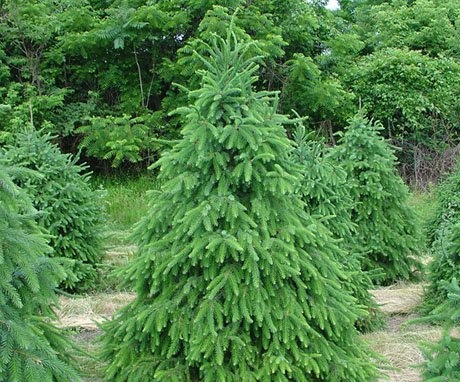
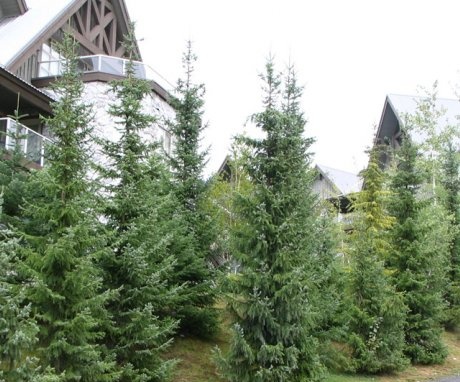

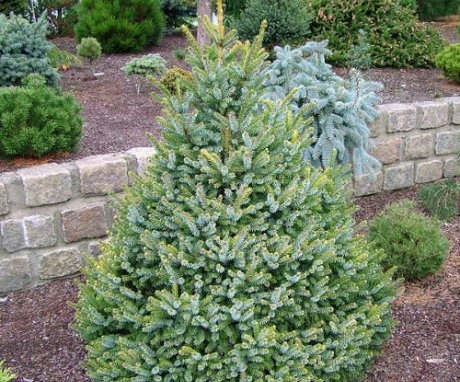
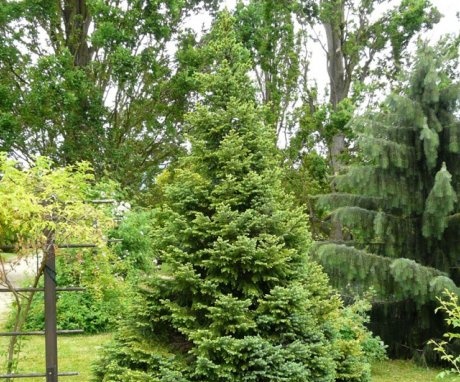
A very beautiful spruce, it has a very dense green crown. In our park, there are three varieties of spruce, but there is definitely no Serbian Omarika among them. The easiest way, in my opinion, is to propagate this spruce using cuttings.